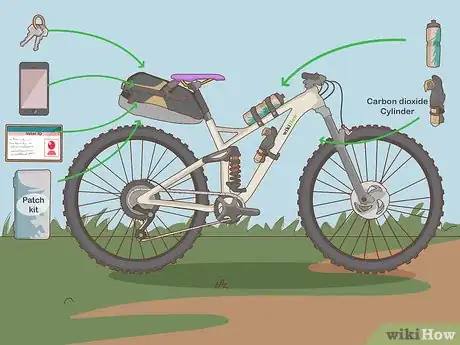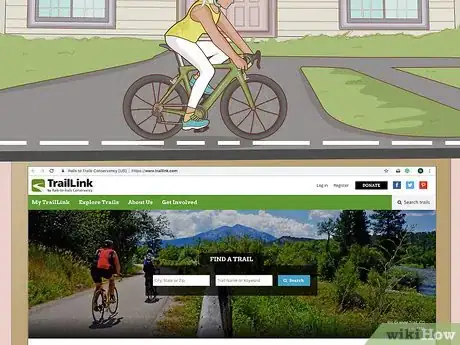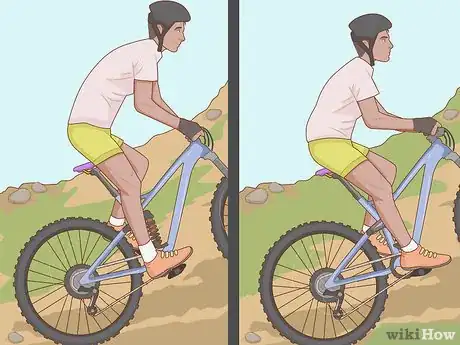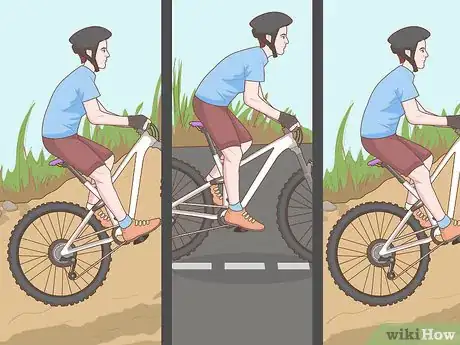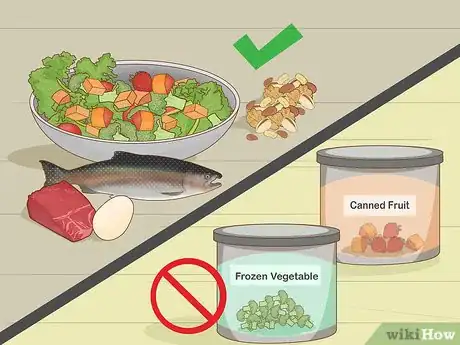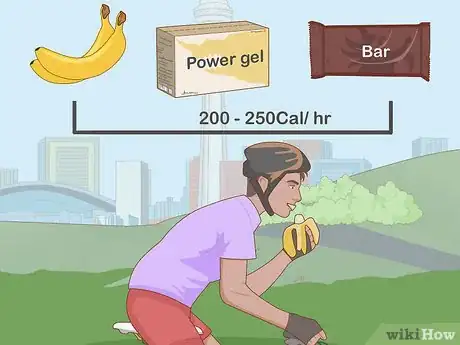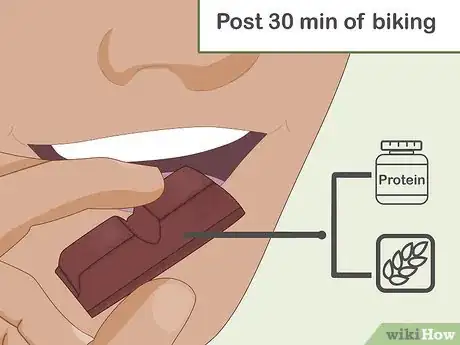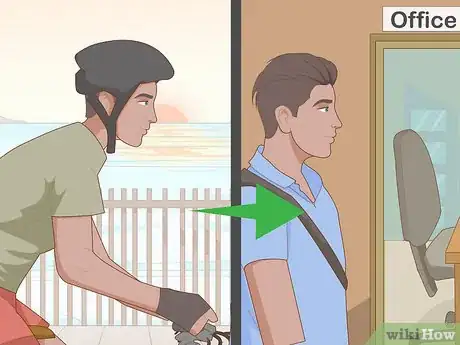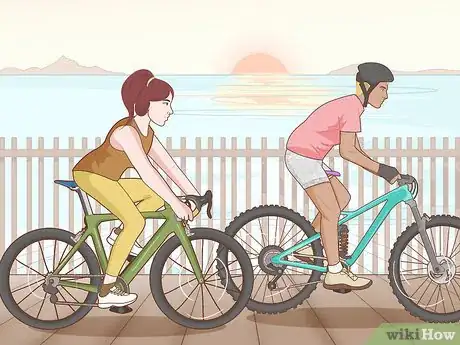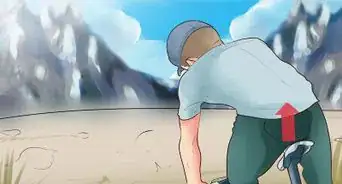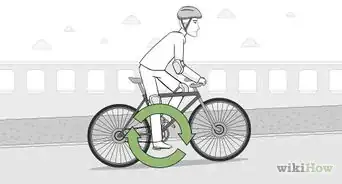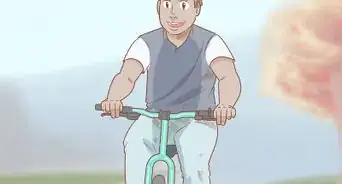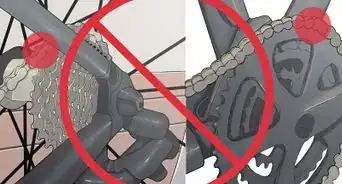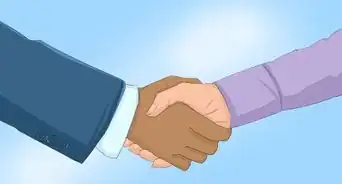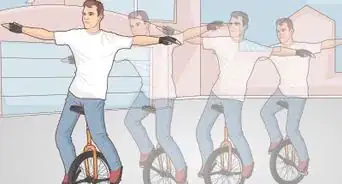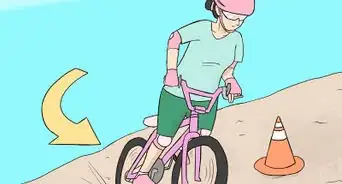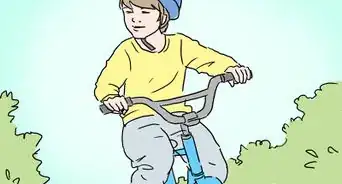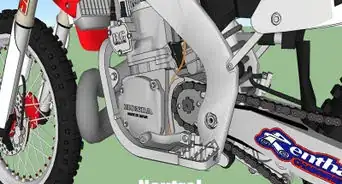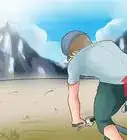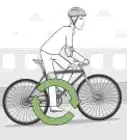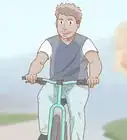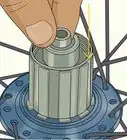This article was co-authored by Kyle Kenny. Kyle Kenny is a Master Trainer, Certified Personal Trainer, and the Owner of KennyTRY Training. With more than seven years of experience, he specializes in helping people achieve their fitness goals by creating individualized meal programs, training regimens, supplementation systems, vitamin lists, and workouts. Kyle has multiple Personal Training Certifications and a Fitness Nutrition Specialist Certification through the National Academy of Sports Medicine.
There are 12 references cited in this article, which can be found at the bottom of the page.
wikiHow marks an article as reader-approved once it receives enough positive feedback. In this case, 100% of readers who voted found the article helpful, earning it our reader-approved status.
This article has been viewed 64,869 times.
Biking can be a great way to lose weight. Unlike some other fitness programs, the learning curve is minimal. Chances are you already know how to ride a bike. Plus, biking is a fun, easy, low-impact exercise that’s easy on your joints, making it accessible to just about anyone regardless of age or fitness level.[1] By starting slowly and sticking to a regular biking routine, you can lose weight and improve your cardiovascular health.
Steps
Choosing Your Gear
-
1Choose your bike. Do you want to bike outdoors or use a stationary bike? The advantage of stationary bikes is that you can do other things while you ride, like watch your favorite TV show.[2] Regular bikes, however, get you outdoors and can have a positive impact on the environment if they replace transport by car.[3] Of course, you can always do both.
- If you choose a regular bike, be aware that there are many different bike styles, from mountain bikes to road bikes to beach cruisers to fixed gear bikes. Bikes can vary widely in price. The type of bike you choose will depend on your body type and on where you plan on riding. Talk to your local dealer, and consider arranging a bike fitting.[4]
- If you choose a stationary bike, you’ll either need to buy one or join a gym. You’ll also need to decide between a recumbent or an upright bike. Choose the former if you have back problems; choose the latter if you don’t. Upright bikes also help strengthen your core.
-
2Pick the right clothes. According to Cornell University weight-loss researcher Brian Wansink, wearing fitted clothes made of lycra instead of baggier outfits makes it easier to keep track of your weight loss. Wansink found that prisoners tend to gain weight because of the baggy jumpsuits they’re forced to wear.[5]Advertisement
-
3Get the right accessories. A helmet is a must-have if you plan on taking your bike on the road. Make sure you buy one that fits you properly.[8] You’ll also want to bring along a patch kit to repair busted tires and a small hand pump to inflate them.[9] If you plan on storing your bike outside, get a bike lock.[10]
- It’s also a good idea to carry a saddlebag to store your ID, your keys, and your phone, which might fall out of your pockets as you ride.[11]
- Carrying a water bottle means that you can stay hydrated while you ride.[12]
- Consider carrying carbon dioxide cylinders in your pack to quickly re-inflate flat tires.
Planning Your Routine
-
1Start slowly.[13] Start out nice and easy in a safe location like your neighborhood before tackling more difficult terrain like hills. Once you get more comfortable, you can begin biking in more high-traffic areas.[14]
- Stick to flat areas at the beginning. Try a local park or bike trail, or find a route using a website like traillink.com.
- When you first start biking, you may not be able to travel more than a few miles. Stay close to home so that you don’t get stranded. You should be able to bike a few miles within a month or so.[15]
- It may be hard in the beginning, but try to implement your training slowly into your routine, always working a little bit everyday.[16]
-
2Alternate the intensity of your ride. Sprinting with high resistance will burn more calories.[17] Riding at a more leisurely pace with low resistance will help build endurance. However, a combination of the two is actually your best bet. A study published in the Journal of Applied Physiology found that alternating between sprinting and endurance burns more calories.[18]
-
3Make recovery time part of your routine.[21] Plan on riding hard one day and then doing a more leisurely “recovery ride” or some cross-training the next. You should plan entire days off too.[22]
- Make sure you’re getting enough sleep and giving yourself breaks between cycling sessions.[23] According to Stacy T. Sims, exercise physiologist at Stanford and founder of Osmo Nutrition, sleep deprivation can lead to false hunger and unnecessary cravings.
- Consider getting a massage on your day off.
-
4Set specific goals. Determine your target weight and estimate how long it will take you to reach this goal. Biking for weight loss is a long-term strategy. Don’t be discouraged if you don’t see immediate results.[24]
- Losing 1 to 2 pounds a week is a sensible, achievable goal.
- Use an online BMI calculator to help determine your ideal weight.
Rethinking Your Diet
-
1Eat breakfast. While there is some disagreement about whether you should eat breakfast before[25] or after biking[26] , eating breakfast nevertheless plays an important role in weight loss.
- Many people associate breakfast with cereal and bacon. However, if you want to lose weight, all of your meals should consist of lots of fruits and vegetables. Fresh fruits and veggies are best, but frozen versions are often excellent. Use caution when buying canned fruits and veggies, which can contain added sodium and sugar.[27]
- For protein, choose lean meats, fish, beans, eggs, and nuts.[28]
-
2
-
3Eat right after biking. The 30 to 60 minutes after your biking session constitute your body’s “recovery time.” Your body needs nutrients to help repair itself.[32]
- Carbohydrates alone help restore glycogen levels. But eating a combination of carbohydrates and protein together means you don’t have to eat as many carbs, which can be difficult after a grueling workout.[33]
- Eating protein also helps to rebuild the muscles that have broken down during your ride.[34]
- Prep your recovery food before you ride in case you’re too tired to put something together when you finish.[35]
-
4
Staying Motivated
-
1Keep your bike visible and accessible. Storing your bike out of sight allows for other priorities to get in the way of your biking routine. According to Stanford health psychologist and fitness instructor Kelly Mc Gonigal , having a reminder to exercise will keep you motivated to do so.[38]
- Store your bike in a place where you will be able to use it.[39]
-
2Vary your routes. An occasional change of scenery will break up the monotony of riding the same route over and over again, and it will present new physical challenges.
-
3Commute by bicycle. You can bike to work or do errands around town on a bike. The average bicycle commuter loses weight without putting forth any extra effort.[40] You’ll also save money on gas and have an easy time finding parking.
- If you’re planning to ride your bike to work, bring a change of clothes and consider showering at the office, if that’s possible. Whatever you do, avoid being too sweaty at work.
- Plan your route to work carefully to make sure you’re not late for work. Make the trip on a day you’re not working so that you can get comfortable with the routine.
-
4Make friends with other bikers. Having friends you can ride with, whether in a spinning class at the gym or on the open road, means that you can exercise and socialize at the same time.[41]
Expert Q&A
-
QuestionCan you lose belly fat by riding a bike?
 Kyle KennyKyle Kenny is a Master Trainer, Certified Personal Trainer, and the Owner of KennyTRY Training. With more than seven years of experience, he specializes in helping people achieve their fitness goals by creating individualized meal programs, training regimens, supplementation systems, vitamin lists, and workouts. Kyle has multiple Personal Training Certifications and a Fitness Nutrition Specialist Certification through the National Academy of Sports Medicine.
Kyle KennyKyle Kenny is a Master Trainer, Certified Personal Trainer, and the Owner of KennyTRY Training. With more than seven years of experience, he specializes in helping people achieve their fitness goals by creating individualized meal programs, training regimens, supplementation systems, vitamin lists, and workouts. Kyle has multiple Personal Training Certifications and a Fitness Nutrition Specialist Certification through the National Academy of Sports Medicine.
Master Trainer & Certified Personal Trainer Possibly, if you pair you're biking with a nutritional plan in mind. The key to weight loss is having a consistent calorie deficit each day.
Possibly, if you pair you're biking with a nutritional plan in mind. The key to weight loss is having a consistent calorie deficit each day. -
QuestionWhat is the best cycling workout?
 Kyle KennyKyle Kenny is a Master Trainer, Certified Personal Trainer, and the Owner of KennyTRY Training. With more than seven years of experience, he specializes in helping people achieve their fitness goals by creating individualized meal programs, training regimens, supplementation systems, vitamin lists, and workouts. Kyle has multiple Personal Training Certifications and a Fitness Nutrition Specialist Certification through the National Academy of Sports Medicine.
Kyle KennyKyle Kenny is a Master Trainer, Certified Personal Trainer, and the Owner of KennyTRY Training. With more than seven years of experience, he specializes in helping people achieve their fitness goals by creating individualized meal programs, training regimens, supplementation systems, vitamin lists, and workouts. Kyle has multiple Personal Training Certifications and a Fitness Nutrition Specialist Certification through the National Academy of Sports Medicine.
Master Trainer & Certified Personal Trainer Start by biking slowly for 30 seconds and then cycling as fast as you can for the next 30 seconds. Keep alternating between fast and slow intervals for 20 minutes, and then bike at a steady pace for another 20 minutes.
Start by biking slowly for 30 seconds and then cycling as fast as you can for the next 30 seconds. Keep alternating between fast and slow intervals for 20 minutes, and then bike at a steady pace for another 20 minutes. -
QuestionHow do I start cycling everyday?
 Alyssa ChangAlyssa Chang is a nutrition coach and trainer, based in the San Francisco Bay Area. She uses her extensive background in brain-based neuroscience to work with clients on improving their connections with their brain and body to heal, reach goals, and move pain-free. She holds a BS in Kinesiology and Exercise, Nutrition and Wellness from the California State University, East Bay and is certified in Precision Nutrition, Z-health Performance and is certified by the National Council for Strength and Fitness.
Alyssa ChangAlyssa Chang is a nutrition coach and trainer, based in the San Francisco Bay Area. She uses her extensive background in brain-based neuroscience to work with clients on improving their connections with their brain and body to heal, reach goals, and move pain-free. She holds a BS in Kinesiology and Exercise, Nutrition and Wellness from the California State University, East Bay and is certified in Precision Nutrition, Z-health Performance and is certified by the National Council for Strength and Fitness.
Wellness Coach & Personal Trainer You just gotta practice and find time in your routine.Try to identify the most effective and efficient way to create change so it doesn't essentially soak up an immense amount of time in your day to day schedule. That said, recovery is often overlooked and it is extremely important, or you're going to feel really poorly.
You just gotta practice and find time in your routine.Try to identify the most effective and efficient way to create change so it doesn't essentially soak up an immense amount of time in your day to day schedule. That said, recovery is often overlooked and it is extremely important, or you're going to feel really poorly.
Warnings
- Cycling builds more muscles, which means that at some point you might actually gain weight.⧼thumbs_response⧽
References
- ↑ Kyle Kenny. Master Trainer & Certified Personal Trainer. Expert Interview. 2 November 2021.
- ↑ http://www.outsideonline.com/1903196/how-lose-weight-while-cycling
- ↑ http://www.weightlossresources.co.uk/logout/sport/cycling.htm
- ↑ http://www.weightlossresources.co.uk/logout/sport/cycling.htm
- ↑ http://www.outsideonline.com/1903196/how-lose-weight-while-cycling
- ↑ http://nbda.com/articles/useful-bicycle-accessories-pg64.htm
- ↑ http://www.active.com/cycling/articles/8-tips-to-lose-weight-from-cycling
- ↑ http://nbda.com/articles/useful-bicycle-accessories-pg64.htm
- ↑ http://nbda.com/articles/useful-bicycle-accessories-pg64.htm
- ↑ http://nbda.com/articles/useful-bicycle-accessories-pg64.htm
- ↑ http://nbda.com/articles/useful-bicycle-accessories-pg64.htm
- ↑ http://nbda.com/articles/useful-bicycle-accessories-pg64.htm
- ↑ Alyssa Chang. Wellness Coach & Personal Trainer. Expert Interview. 16 October 2019.
- ↑ http://www.weightlossresources.co.uk/logout/sport/cycling.htm
- ↑ http://www.weightlossresources.co.uk/logout/sport/cycling.htm
- ↑ Alyssa Chang. Wellness Coach & Personal Trainer. Expert Interview. 16 October 2019.
- ↑ Kyle Kenny. Master Trainer & Certified Personal Trainer. Expert Interview. 2 November 2021.
- ↑ http://www.outsideonline.com/1903196/how-lose-weight-while-cycling
- ↑ http://www.active.com/cycling/articles/8-tips-to-lose-weight-from-cycling
- ↑ Kyle Kenny. Master Trainer & Certified Personal Trainer. Expert Interview. 2 November 2021.
- ↑ Alyssa Chang. Wellness Coach & Personal Trainer. Expert Interview. 16 October 2019.
- ↑ http://www.bicycling.com/training/fitness/simple-training-plan-lose-weight-ride-faster
- ↑ Alyssa Chang. Wellness Coach & Personal Trainer. Expert Interview. 16 October 2019.
- ↑ Kyle Kenny. Master Trainer & Certified Personal Trainer. Expert Interview. 2 November 2021.
- ↑ http://www.outsideonline.com/1903196/how-lose-weight-while-cycling
- ↑ http://www.active.com/cycling/articles/8-tips-to-lose-weight-from-cycling
- ↑ http://www.cdc.gov/healthyweight/healthy_eating/index.html
- ↑ http://www.cdc.gov/healthyweight/healthy_eating/index.html
- ↑ http://www.active.com/cycling/articles/8-tips-to-lose-weight-from-cycling
- ↑ http://www.outsideonline.com/1903196/how-lose-weight-while-cycling
- ↑ http://www.outsideonline.com/1903196/how-lose-weight-while-cycling
- ↑ http://www.active.com/nutrition/articles/6-eating-habits-that-sabotage-your-cycling?page=2
- ↑ http://breakingmuscle.com/mobility-recovery/eating-to-recover-how-and-what-to-eat-post-workout
- ↑ http://breakingmuscle.com/mobility-recovery/eating-to-recover-how-and-what-to-eat-post-workout
- ↑ http://www.active.com/nutrition/articles/6-eating-habits-that-sabotage-your-cycling?page=2
- ↑ http://www.active.com/nutrition/articles/6-eating-habits-that-sabotage-your-cycling?page=2
- ↑ http://www.brown.edu/Student_Services/Health_Services/Health_Education/alcohol,_tobacco,_&_other_drugs/energy_drinks.php
- ↑ http://www.fitnessmagazine.com/workout/tips/habits-of-effective-exercisers/
- ↑ http://www.fitnessmagazine.com/workout/tips/habits-of-effective-exercisers/
- ↑ http://www.outsideonline.com/1903196/how-lose-weight-while-cycling
- ↑ http://www.fitnessmagazine.com/workout/tips/habits-of-effective-exercisers/



